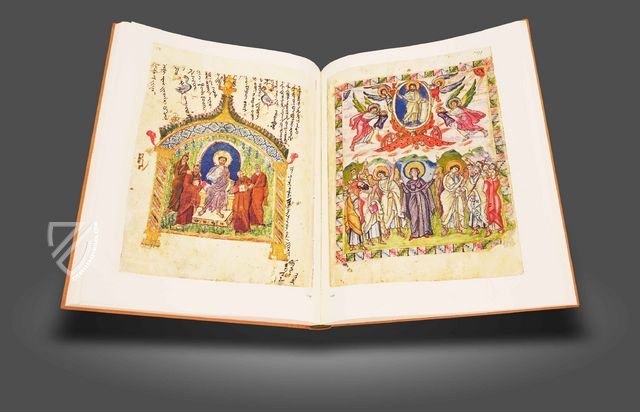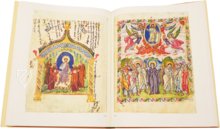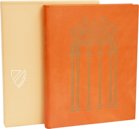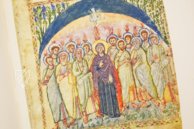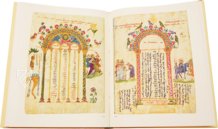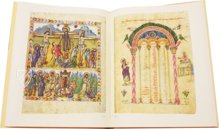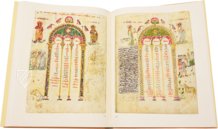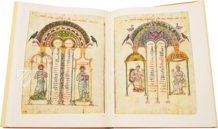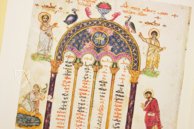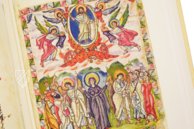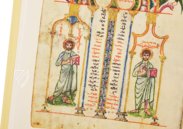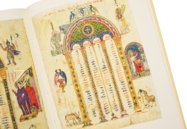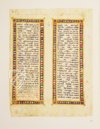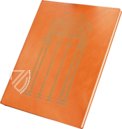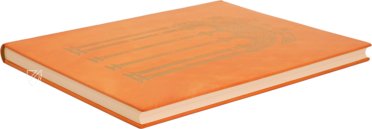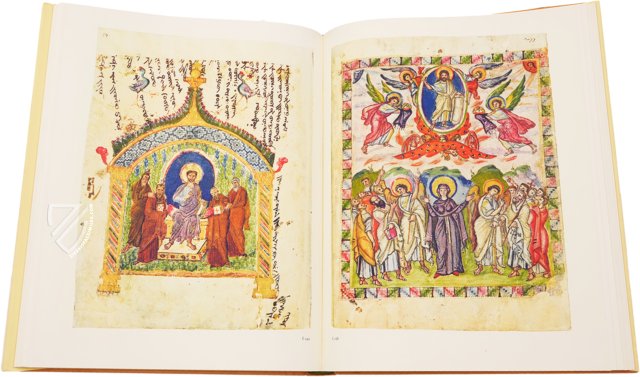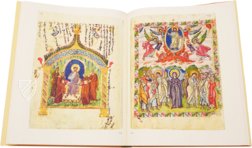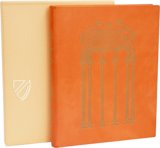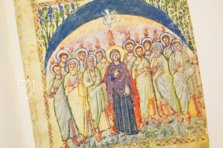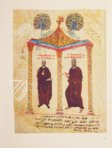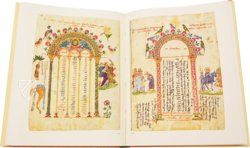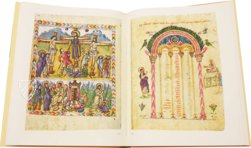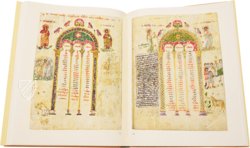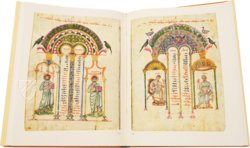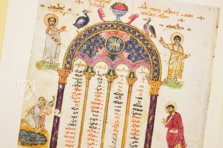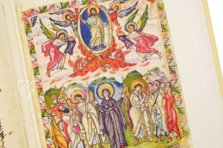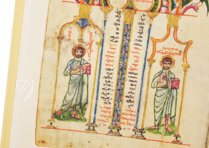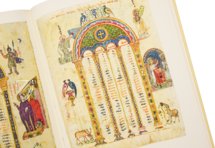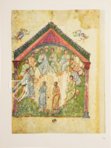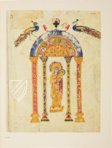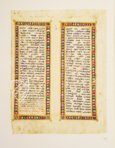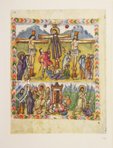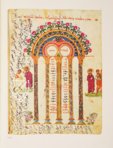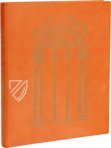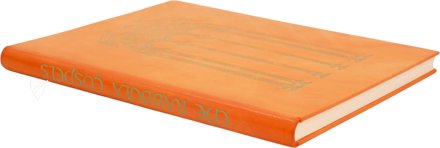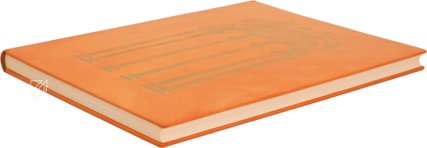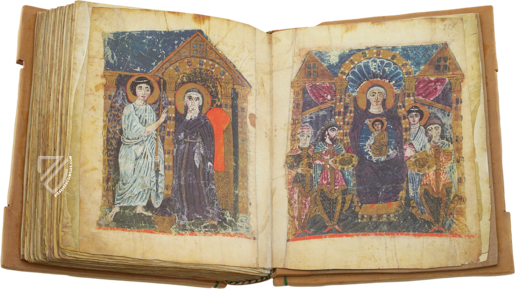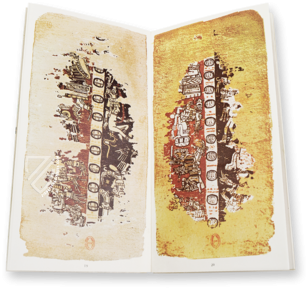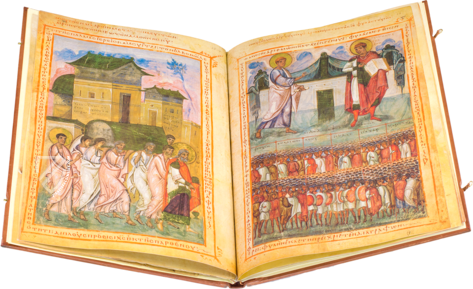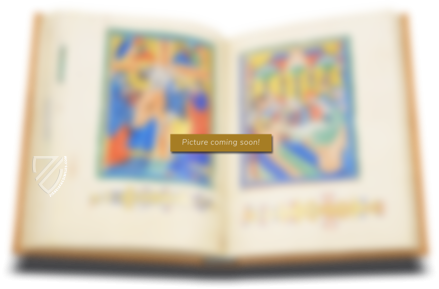Rabbula Gospels
(1,000€ - 3,000€)
Completed in 586, the Rabbula Gospels is simultaneously one of the finest Byzantine manuscripts produced in Asia as well as one of the earliest Christian manuscripts to be furnished with large miniatures, which are distinguished by their bright colors, dynamism, drama, and expressiveness. Elaborate floral and architectural motifs frame the miniatures, which include the oldest surviving depiction of the Crucifixion found in a manuscript and shows the contemporary Eastern form of the image. The Syriac manuscript was produced in the scriptorium of the Monastery of St. John of Zagba in modern day Syria and is one of the few specimens to survive the destruction of countless Byzantine manuscripts and works of art during the Iconoclasm of the 8th and 9th centuries. This precious artifact is named after the scribe Rabbula, who signed his name in the manuscript and about whom nothing else in known. Parts of the manuscript were overpainted by restorers and miniatures from other works were added in the 15th and 16th centuries.
Rabbula Gospels
This famous 6th century manuscript is distinguished by its age, rarity, and the art-historical significance of its miniatures, which are clearly the work of an experienced artist. Its text consists of the Peshitta version of the Syriac translation of the Gospels, which is written in two columns using dark brown, black, and red ink. Seven full-page miniatures illustrating the text are brightly colored, dynamic, dramatic, and expressive. They represent rare and precious artifacts of Byzantine art that managed to survive destruction at the hands of Iconoclasts and provide an example of Late Antique art from the Eastern Mediterranean. Finally, the codex also served as a register of the Maronite patriarchs of Antioch during the Middle Ages. The Rabbula Gospels thus represents a true “triple threat” for bibliophiles.
A Mix of Artistic Traditions
Aside from being one of the finest Byzantine manuscripts originating in Asia, the manuscript is significant for being one of the first to be furnished with large miniatures. They are the work of an anonymous professional artist trained in the classical illusionist tradition who also borrowed from Hellenistic art, especially the draped figures, as well as Persian artistic traditions. Some miniatures are framed by elaborate floral and architectural motifs, others by colorful patterns including zigzags, curves, and rainbows. Its canon tables are presented in arcades with flowers, birds, animals, and marginal miniatures of biblical scenes. The Crucifixion miniature is the oldest found in an illuminated manuscript and is an example of the Eastern archetype of the image. It also features an extremely rare miniature of the Apostles choosing a new member to replace Judas, a scene not founded in the Gospels but mentioned in the Acts of the Apostles. These images are treasured by art historians as rare examples of the style and iconography of the period.
History of the Manuscript
Signed by the anonymous scribe Rabbula, the Gospel Book is believed to have been made in the Monastery of St. John of Zagba and completed in the year 586. Its original size is not known because it was trimmed when it was rebound several times over the centuries, but the folios currently measure 34 x 27 cm. The fate of the manuscript between the 6th and 11th centuries is not known, including how and why it survived the Iconoclasm when so many other illuminated manuscripts did not. It was recorded as being in Maipuc-Byblos, Lebanon in the 11th century before coming to Quannubin in the Kadisha Valley around the turn of the 14th century. The Maronite Patriarch brought the manuscript to its current repository, the Laurentian Library in Florence, in the late-15th or early-16th century. Recent scholarship suggests that the text and miniatures were originally separate volumes that were bound together in the 15th century.
Codicology
- Alternative Titles
- Rabbula Evangeliar
Rabula Evangeliar
Rabula Gospels
Evangeliarii syriaci, vulgo Rabbulae - Size / Format
- 586 pages / 33.8 × 27.9 cm
- Origin
- Syria
- Date
- 586
- Epochs
- Style
- Genre
- Script
- Estrangela
- Illustrations
- 7 full-page miniatures and 19 illuminated canon tables
- Content
- Four Gospels, later integrated list of pericopes
- Artist / School
- Rabbula (scribe)
Rabbula Gospels
Moses Receives the 10 Commandments
This Old Testament depiction belongs to one of the beautifully illuminated canon tables of the Gospel Book, all of which are decorated with small marginal scenes. After Moses liberated the Israelites from Egypt, they came to the Sinai desert. They camped at Mount Sinai, but God forbade them to tread on it. On the third day, God came down on the mountain with thunder, lightning and fire, indicated by small flames in the green ground, and called Moses to Himself. On the summit both held converse and God handed over to Moses out of a cloud the tablets of the law with the Ten Commandments - here represented as a hand coming out of a blue sphere.
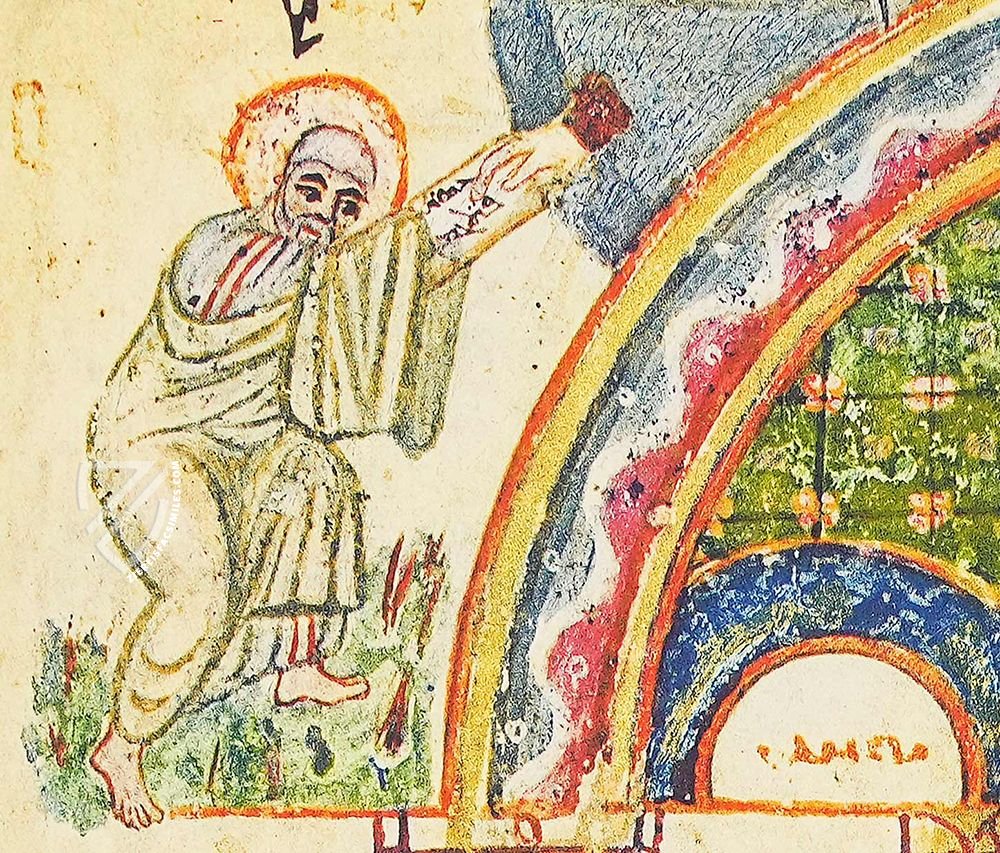
Rabbula Gospels
Crucifixion, Women at the Tomb and Noli Me Tangere
The upper register of this mosaic-framed picture page shows one of the oldest depictions of the Crucifixion in Christian art. The center of the miniature is Christ on the cross, wrapped in an incomplete purple robe with golden stripes that set him apart from the two half-naked thieves on the left and right. While a soldier in a red tunic stabs his lance into his side, another offers him a sponge soaked in vinegar. At the foot of the cross, three more soldiers dice around the purple mantle of Christ. The action is watched in dismay by three mourning women on the right and the grieving Virgin Mary and John on the left. The sun and moon at the top of the painting, however, simultaneously glorify Christ and point to the universal significance of his sacrificial death.
The lower register shows three subsequent scenes surrounding Christ's empty tomb. Red rays erupt from the gorgeous mausoleum, blinding the three guards and knocking them to the ground. Here a conception of Christ's Resurrection, for which there are no eyewitnesses in the Bible, is carried into the image. Then, on the left, Mary and Mary Magdalene come to the empty tomb with ointment jars, where an angel is already waiting for them to announce the incredible message. On the right they meet Jesus, who commands them with his saying "Noli me tangere" not to touch him or to hold him but to let him go.
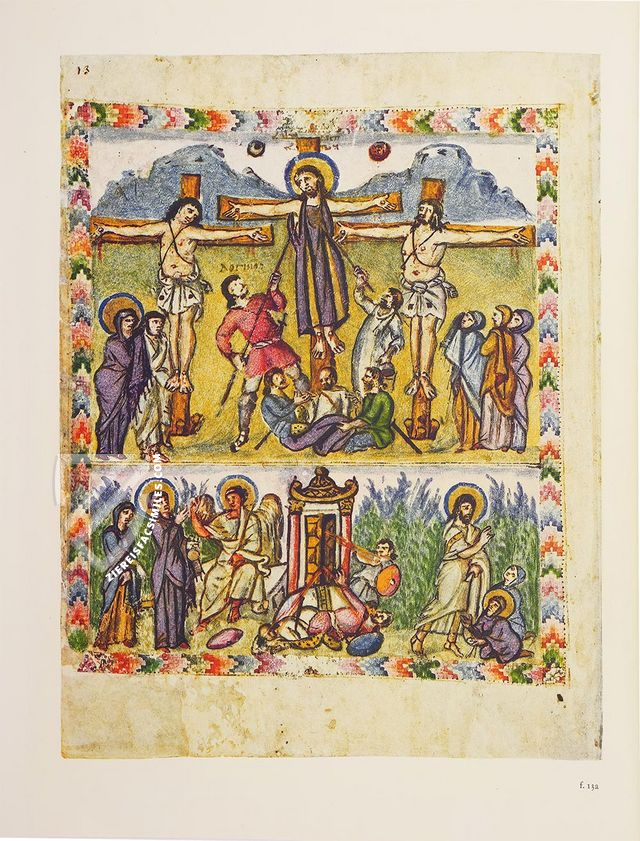
#1 The Rabbula Gospels
Language: English
(1,000€ - 3,000€)
- Treatises / Secular Books
- Apocalypses / Beatus
- Astronomy / Astrology
- Bestiaries
- Bibles / Gospels
- Chronicles / History / Law
- Geography / Maps
- Saints' Lives
- Islam / Oriental
- Judaism / Hebrew
- Single Leaf Collections
- Leonardo da Vinci
- Literature / Poetry
- Liturgical Manuscripts
- Medicine / Botany / Alchemy
- Music
- Mythology / Prophecies
- Psalters
- Other Religious Books
- Games / Hunting
- Private Devotion Books
- Other Genres
- Afghanistan
- Armenia
- Austria
- Belgium
- Belize
- Bosnia and Herzegovina
- China
- Colombia
- Costa Rica
- Croatia
- Cyprus
- Czech Republic
- Denmark
- Egypt
- El Salvador
- Ethiopia
- France
- Germany
- Greece
- Guatemala
- Honduras
- Hungary
- India
- Iran
- Iraq
- Israel
- Italy
- Japan
- Jordan
- Kazakhstan
- Kyrgyzstan
- Lebanon
- Liechtenstein
- Luxembourg
- Mexico
- Morocco
- Netherlands
- Palestine
- Panama
- Peru
- Poland
- Portugal
- Romania
- Russia
- Serbia
- Spain
- Sri Lanka
- Sweden
- Switzerland
- Syria
- Tajikistan
- Turkey
- Turkmenistan
- Ukraine
- United Kingdom
- United States
- Uzbekistan
- Vatican City
- A. Oosthoek, van Holkema & Warendorf
- Aboca Museum
- Ajuntament de Valencia
- Akademie Verlag
- Akademische Druck- u. Verlagsanstalt (ADEVA)
- Aldo Ausilio Editore - Bottega d’Erasmo
- Alecto Historical Editions
- Alkuin Verlag
- Almqvist & Wiksell
- Amilcare Pizzi
- Andreas & Andreas Verlagsbuchhandlung
- Archa 90
- Archiv Verlag
- Archivi Edizioni
- Arnold Verlag
- ARS
- Ars Magna
- ArtCodex
- AyN Ediciones
- Azimuth Editions
- Badenia Verlag
- Bärenreiter-Verlag
- Belser Verlag
- Belser Verlag / WK Wertkontor
- Benziger Verlag
- Bernardinum Wydawnictwo
- BiblioGemma
- Biblioteca Apostolica Vaticana (Vaticanstadt, Vaticanstadt)
- Bibliotheca Palatina Faksimile Verlag
- Bibliotheca Rara
- Boydell & Brewer
- Bramante Edizioni
- Bredius Genootschap
- Brepols Publishers
- British Library
- C. Weckesser
- Caixa Catalunya
- Canesi
- CAPSA, Ars Scriptoria
- Caratzas Brothers, Publishers
- Carus Verlag
- Casamassima Libri
- Centrum Cartographie Verlag GmbH
- Chavane Verlag
- Christian Brandstätter Verlag
- Circulo Cientifico
- Club Bibliófilo Versol
- Club du Livre
- CM Editores
- Collegium Graphicum
- Collezione Apocrifa Da Vinci
- Comissão Nacional para as Comemorações dos Descobrimentos Portugueses
- Coron Verlag
- Corvina
- CTHS
- D. S. Brewer
- Damon
- De Agostini/UTET
- De Nederlandsche Boekhandel
- De Schutter
- Deuschle & Stemmle
- Deutscher Verlag für Kunstwissenschaft
- DIAMM
- Droz
- E. Schreiber Graphische Kunstanstalten
- Ediciones Boreal
- Ediciones Grial
- Ediclube
- Edições Inapa
- Edilan
- Editalia
- Edition Deuschle
- Edition Georg Popp
- Edition Leipzig
- Edition Libri Illustri
- Editiones Reales Sitios S. L.
- Éditions de l'Oiseau Lyre
- Editions Medicina Rara
- Editorial Casariego
- Editorial Mintzoa
- Editrice Antenore
- Editrice Velar
- Edizioni Edison
- Egeria, S.L.
- Eikon Editores
- Electa
- Emery Walker Limited
- Enciclopèdia Catalana
- Eos-Verlag
- Ephesus Publishing
- Ernst Battenberg
- Eugrammia Press
- Extraordinary Editions
- Fackelverlag
- Facsimila Art & Edition
- Facsimile Editions Ltd.
- Facsimilia Art & Edition Ebert KG
- Faksimile Verlag
- Feuermann Verlag
- Folger Shakespeare Library
- Franco Cosimo Panini Editore
- Friedrich Wittig Verlag
- Fundación Hullera Vasco-Leonesa
- G. Braziller
- Gabriele Mazzotta Editore
- Gebr. Mann Verlag
- Gesellschaft für graphische Industrie
- Getty Research Institute
- Giovanni Domenico de Rossi
- Giunti Editore
- Graffiti
- Grafica European Center of Fine Arts
- Guido Pressler
- Guillermo Blazquez
- Gustav Kiepenheuer
- H. N. Abrams
- Harrassowitz
- Harvard University Press
- Helikon
- Hendrickson Publishers
- Henning Oppermann
- Herder Verlag
- Hes & De Graaf Publishers
- Hoepli
- Holbein-Verlag
- Houghton Library
- Hugo Schmidt Verlag
- Idion Verlag
- Il Bulino, edizioni d'arte
- ILte
- Imago
- Insel Verlag
- Insel-Verlag Anton Kippenberger
- Instituto de Estudios Altoaragoneses
- Instituto Nacional de Antropología e Historia
- Introligatornia Budnik Jerzy
- Istituto dell'Enciclopedia Italiana - Treccani
- Istituto Ellenico di Studi Bizantini e Postbizantini
- Istituto Geografico De Agostini
- Istituto Poligrafico e Zecca dello Stato
- Italarte Art Establishments
- Jan Thorbecke Verlag
- Johnson Reprint Corporation
- Josef Stocker
- Josef Stocker-Schmid
- Jugoslavija
- Karl W. Hiersemann
- Kasper Straube
- Kaydeda Ediciones
- Kindler Verlag / Coron Verlag
- Kodansha International Ltd.
- Konrad Kölbl Verlag
- Kurt Wolff Verlag
- La Liberia dello Stato
- La Linea Editrice
- La Meta Editore
- Lambert Schneider
- Landeskreditbank Baden-Württemberg
- Leo S. Olschki
- Les Incunables
- Liber Artis
- Library of Congress
- Libreria Musicale Italiana
- Lichtdruck
- Lito Immagine Editore
- Lumen Artis
- Lund Humphries
- M. Moleiro Editor
- Maison des Sciences de l'homme et de la société de Poitiers
- Manuscriptum
- Martinus Nijhoff
- Maruzen-Yushodo Co. Ltd.
- MASA
- Massada Publishers
- McGraw-Hill
- Metropolitan Museum of Art
- Militos
- Millennium Liber
- Müller & Schindler
- Nahar - Stavit
- Nahar and Steimatzky
- National Library of Wales
- Neri Pozza
- Nova Charta
- Oceanum Verlag
- Odeon
- Orbis Mediaevalis
- Orbis Pictus
- Österreichische Staatsdruckerei
- Oxford University Press
- Pageant Books
- Parzellers Buchverlag
- Patrimonio Ediciones
- Pattloch Verlag
- PIAF
- Pieper Verlag
- Plon-Nourrit et cie
- Poligrafiche Bolis
- Presses Universitaires de Strasbourg
- Prestel Verlag
- Princeton University Press
- Prisma Verlag
- Priuli & Verlucca, editori
- Pro Sport Verlag
- Propyläen Verlag
- Pytheas Books
- Quaternio Verlag Luzern
- Reales Sitios
- Recht-Verlag
- Reichert Verlag
- Reichsdruckerei
- Reprint Verlag
- Riehn & Reusch
- Roberto Vattori Editore
- Rosenkilde and Bagger
- Roxburghe Club
- Salerno Editrice
- Saltellus Press
- Sandoz
- Sarajevo Svjetlost
- Schöck ArtPrint Kft.
- Schulsinger Brothers
- Scolar Press
- Scrinium
- Scripta Maneant
- Scriptorium
- Shazar
- Siloé, arte y bibliofilia
- SISMEL - Edizioni del Galluzzo
- Sociedad Mexicana de Antropología
- Société des Bibliophiles & Iconophiles de Belgique
- Soncin Publishing
- Sorli Ediciones
- Stainer and Bell
- Studer
- Styria Verlag
- Sumptibus Pragopress
- Szegedi Tudomànyegyetem
- Taberna Libraria
- Tarshish Books
- Taschen
- Tempus Libri
- Testimonio Compañía Editorial
- Thames and Hudson
- The Clear Vue Publishing Partnership Limited
- The Facsimile Codex
- The Folio Society
- The Marquess of Normanby
- The Richard III and Yorkist History Trust
- Tip.Le.Co
- TouchArt
- TREC Publishing House
- TRI Publishing Co.
- Trident Editore
- Tuliba Collection
- Typis Regiae Officinae Polygraphicae
- Union Verlag Berlin
- Universidad de Granada
- University of California Press
- University of Chicago Press
- Urs Graf
- Vallecchi
- Van Wijnen
- VCH, Acta Humaniora
- VDI Verlag
- VEB Deutscher Verlag für Musik
- Verlag Anton Pustet / Andreas Verlag
- Verlag Bibliophile Drucke Josef Stocker
- Verlag der Münchner Drucke
- Verlag für Regionalgeschichte
- Verlag Styria
- Vicent Garcia Editores
- W. Turnowski Ltd.
- W. Turnowsky
- Waanders Printers
- Wiener Mechitharisten-Congregation (Wien, Österreich)
- Wissenschaftliche Buchgesellschaft
- Wissenschaftliche Verlagsgesellschaft
- Wydawnictwo Dolnoslaskie
- Xuntanza Editorial
- Zakład Narodowy
- Zollikofer AG

